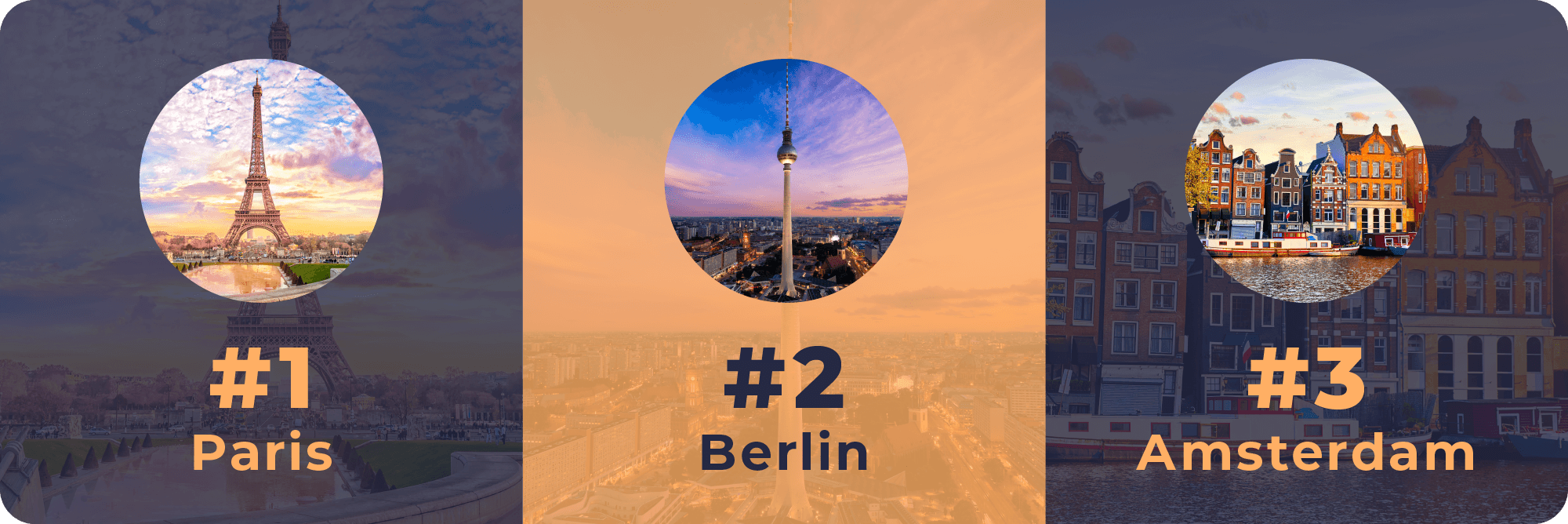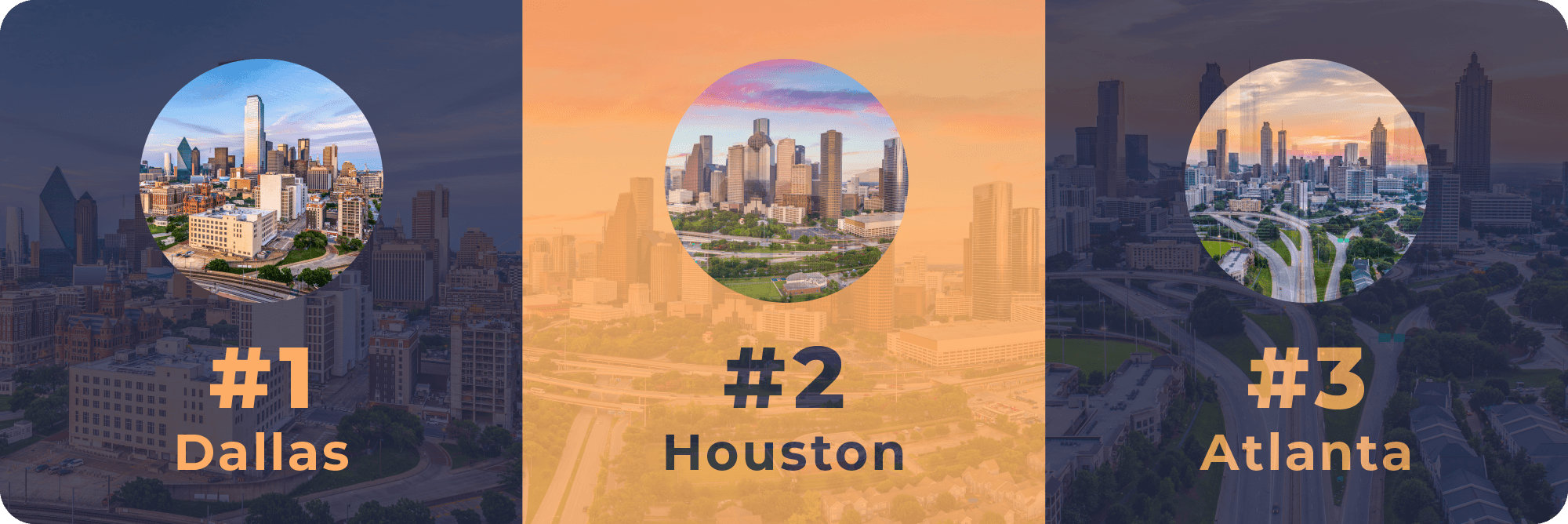The Burrow

If you have gone traveling before, you might be familiar with the stress incurred simply from trying to figure out how to best get around.
Getting from point A to point B in a place you aren’t familiar with can be difficult, costly and stressful. Depending on your itinerary, destination and preferences, sometimes the best option might be to hire a car – but there are many places where it might be far easier to get by without one.

As experts in how travel insurance could keep you covered while getting around overseas, the team at Compare the Market Australia wanted to figure out the best cities to visit if you don’t want to (or can’t) drive a car.
To do this, we ranked 25 cities around the world based on seven different factors relating to mobility, accommodation and activities. Here’s what we found:



Coming in at the top spot on our list, Paris scores an astonishing 92.28/100 on our index. Not only was Paris ranked first place in both the public transport and bikeshare categories, but it also managed to take home second place in bikeability, accommodation and things to do, while also scoring very well for walkability.
Given some of the steps that the city has taken in recent times to make the city less car-centric, it may come as little surprise that the French capital performed so well in this index.
Paris has a number of pedestrianised and car-free areas, regularly restricting areas of the city to car traffic and holds car-free days to allow people to explore without being bothered by traffic!1
The city also recently added over 50km of pop-up bike lanes during the coronavirus pandemic, which they later announced they would be keeping as part of their plan to make Paris “100% cyclable”.2
With the Paris Olympics less than a year away, it’s great to see that the city is making efforts to make the events accessible to visitors without ever having to drive a car!
The German capital ranks second overall on our index. The city received very high scores in public transport and bikeability, but lacks walkability compared to some of the other top-performing cities on our list.
Similar to Paris, Berlin has many pedestrian-first and walkable projects that are helping make it more convenient and pleasant to get around the city car-free. For example, since 2019, various analogue and digital information pillars have been installed at eight locations around the city (with up to 220 additional sites expected over the coming years) as part of the “tourist information system,” which aims to help tourists and locals better orient and navigate the city on foot!4
No list of car-free cities would be complete without mentioning the Dutch city of Amsterdam. Famous – among other things – for its bicycling culture and pedestrian-first city planning, it might come as little surprise to know that this Dutch city scored extremely well for bikeability and public transport. The category bringing Amsterdam down the most was the relatively high price of a taxi, at almost AU$4 per kilometre – the sixth most expensive on our list.
Amsterdam is no stranger to car-free projects and experiments. In June of this year, the city closed one of their busiest streets – Weesperstraat – for six weeks as part of an experiment to test how the closure affected the quality of life of the neighbourhood.5
If you are traveling to Amsterdam, it probably just wouldn’t feel right to hire a car instead of exploring this beautiful city on two wheels (or feet), like so many of its residents do every day!
While other North American cities score moderately higher on our list (namely New York and San Francisco), seven of the bottom 10 cities on this index can be found somewhere in the USA or Canada. Specifically, the USA is three-for-three when it comes to the worst places to visit without a car, with all three bottom cities located in the land of the free.

Dallas, Texas, takes the lowest spot on our index, with a lowly overall score of only 9.44/100, proving that not everything is bigger in Texas. Dallas may not be the absolute worst in any one category but comes extremely close across the board.
Houston, we have a problem! Well, we might have a problem trying to get around this Texan city without a car at least. The second-lowest city on our index, Houston scored just 10.14/100 overall. While the city scored very low in most categories (including the most expensive taxi trip, at almost AU$5 per kilometre), Houston has a surprising number of accommodation options, which helped to push this city above Its Texan neighbour.
The third-lowest city on our list is Atlanta. Similar to Dallas and Houston, Atlanta suffers from low scores across all categories, but fares especially bad when it comes to walkability, where Atlanta received the lowest rank on our list.

Taking a look at the overall data, it becomes obvious that some regions perform generally better than others. European cities performed extremely well, landing eight of the top 10 spots on the index. In comparison, North American cities tended to underperform. Only New York made the top 10 with San Francisco close behind in 11th place, while seven of the bottom 10 cities were in the USA or Canada.
So how did Australian cities rank? Well, not amazingly. This index only included data for Sydney (ranked 13th) and Brisbane (ranked 22nd). While Sydney had a good score for public transport, it was let down by low scores across most of the remaining categories. Brisbane, on the other hand, scored well for taxi costs, while similarly scoring poorly everywhere else. Importantly, public transport data was unavailable for Brisbane – considering the city’s extensive bus, train and ferry network, if this data was available the city could possibly have scored a little bit higher.

So why exactly would somebody want to visit a city completely car-less? Well, there are a few potential reasons to consider, but ultimately each person has to evaluate their own preferences and requirements to determine which methods of getting around are best for them!
Here are a few reasons to consider:
It’s no secret that driving can be expensive. Fuel, parking and hire costs can add up quickly, and can mean that sometimes going without is the cheaper alternative!
Different signage, road rules, etiquette and even the correct side of the road varies from place to place. Especially if you don’t know the area, sometimes it might be less stressful to leave driving to somebody else instead, and just take the bus.
This one speaks for itself. Parking can be expensive, and – especially in busy cities and points of interest – limited.
Since driving focuses so much of your attention on the road, it can be easy to miss a lot of small details that give a city its unique character. This is especially true if you drive the busy, main roads to get around. These are often designed to get drivers from point A to point B, rather than letting people explore and sightsee. The journey can be just as, or even more, fun than the destination – sometimes it can be nice to slow down and enjoy it!
From the cable cars of San Francisco and the iconic red double-decker buses of London, to the massive bicycle fleets of Amsterdam, sometimes the different ways to get around are part of the draw and character of the places you visit.

General Manager of General Insurance at Compare the Market Australia, Adrian Taylor, said that no matter how you plan to get around, travel insurance could help your piece of mind while on holiday.
“Without having a car to keep all your belongings in while travelling, it can be easy to misplace or lose track your possessions, especially while exploring an unfamiliar destination.
“Having travel insurance could help cover the cost of replacement items in the event they are lost or stolen.”
Mr Taylor also explained that travel insurance could help if the event that public transport runs into trouble, by covering the cost of backup transport and getting you to your destination on time, provided you have pre-purchased a ticket to your desired event or attraction.
“Having travel insurance could help turn a potential disaster into a mere annoyance and allow you to keep enjoying your holiday without unnecessary stress and difficulty.”
If you do decide to invest in some travel insurance, it is a good idea to read the PDS beforehand to ensure the plan is right for your individual circumstances.
In order to determine the overall score for each city, data across seven different categories was collected. Each score was then normalised and weighted, and then the average score was calculated for each city:
Public transport (25% weight): The Oliver Wyman Forum urban Mobility Readiness index
Walkability (20% weight): An overall score for each city was calculated by averaging the values for “people near services,” “people near transit,” “block density,” “weighted population density,” and “car-free places” listed for each city on Pedestrians First. For the “block density,” and “weighted population density” stats, the result was divided by the stated target (80 blocks / square km and 15,000 people / square km respectively) to express the value as a percentage before averaging.
Bikeability (15% weight): PeopleForBikes
Bikeshare density (10% weight): The max number of available sharebikes over the last 24 hours for each current, listed provider was collected and summed for each city on bikesharemap.com. This value was then divided by the urban footprint of the built-up, urban area sourced from Demographia World Urban Areas 19th Annual Edition (August 2023), to calculate an approximate, average density.
Cost of a 1km taxi trip (10% weight): Numbeo
Places to stay (10% weight): Values were found manually by looking at the number of accommodation listed on Tripadvisor for each city.
Things to do (10% weight): Values were found manually by looking at the number of attractions listed on Tripadvisor for each city.
Airport linked by rail:
A further penalty of 15% was then applied to any city (by multiplying the averaged score by 0.85) that does not have a rail connection to the international airport. This was manually researched for each city, using the following sources:
Data was collected between the 7th and 15th of November and was accurate as of the time of collection.
Additional sources:
